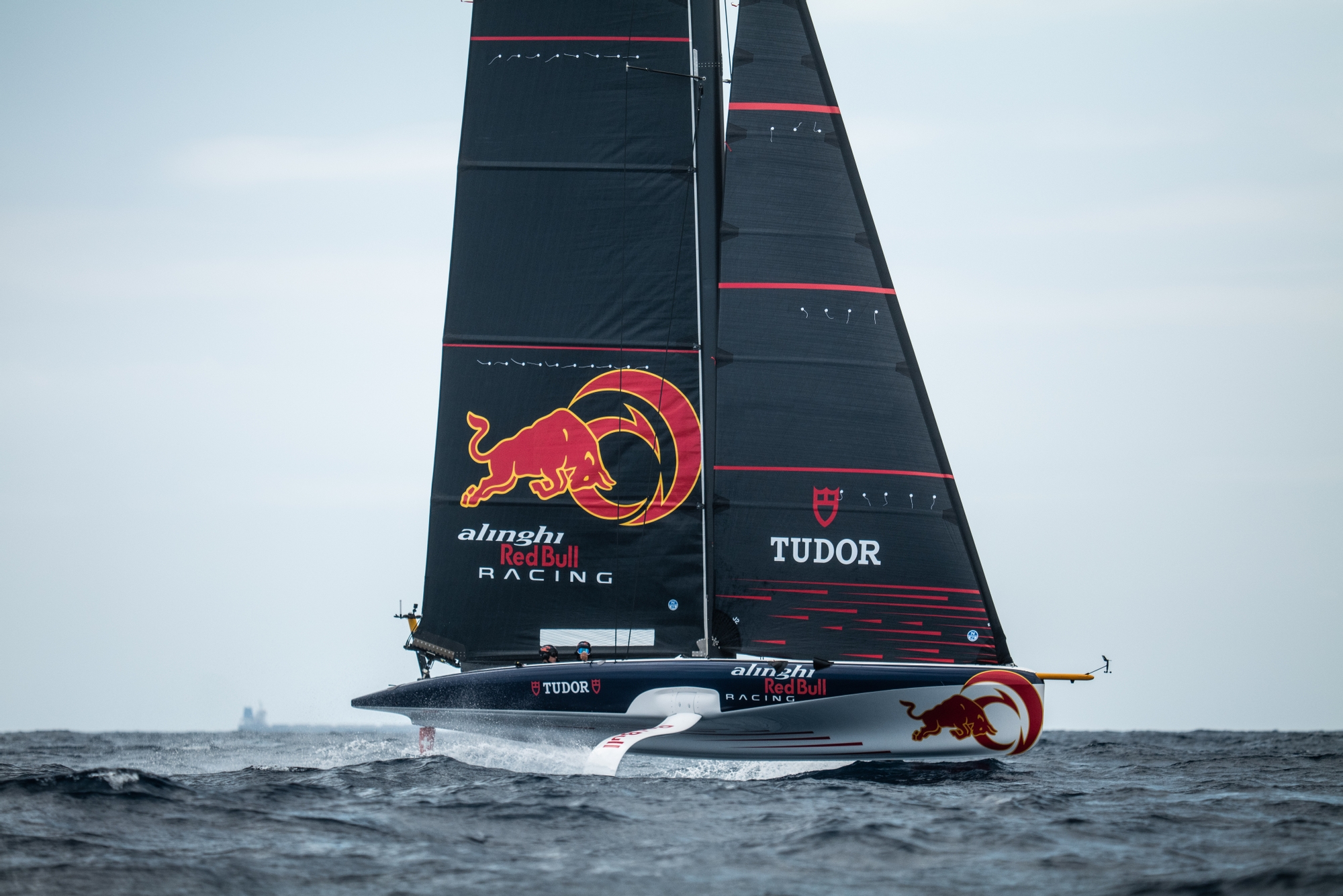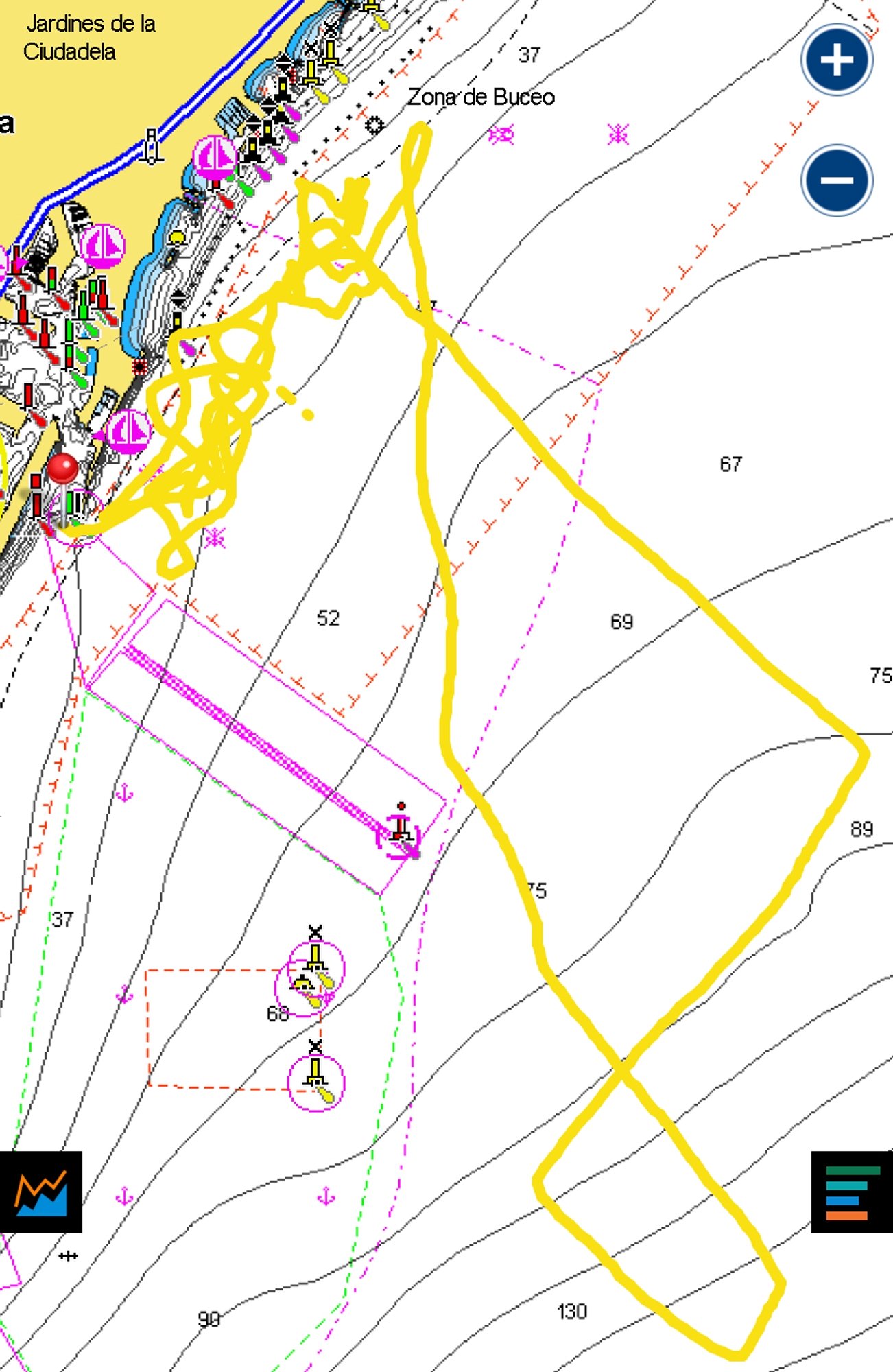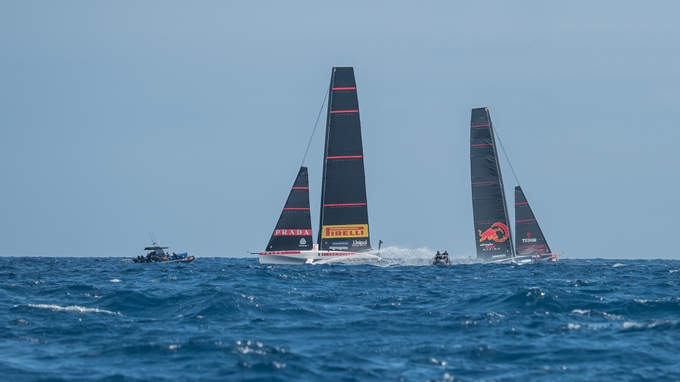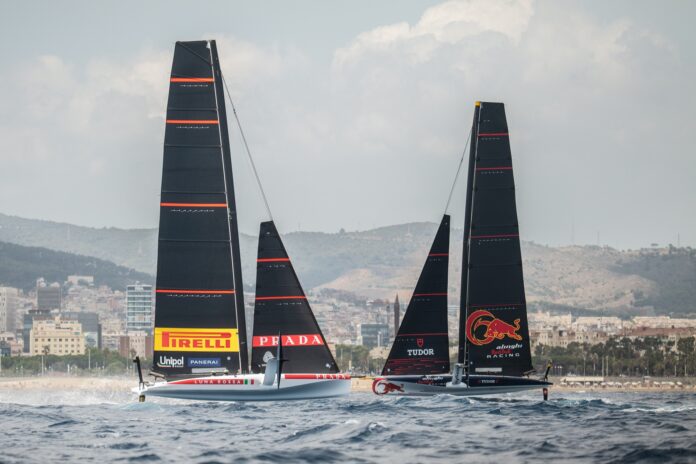Barcelona was a busy waterway on Monday with Emirates Team New Zealand, Alinghi Red Bull Racing and Luna Rossa Prada Pirelli all out training on a perfect day with a building southerly breeze that topped out at around 17 knots in the late afternoon and a powerful easterly swell that made upwind data analysis a dark art. Towing out of the Port Vell at exactly the same time, Emirates Team New Zealand’s AC75 ‘Te Rehutai’ dominated the spectacle dwarfing Alinghi Red Bull Racing’s modified AC40 but out on the water both were absolutely sending it around the racecourse area just off the Barceloneta beachfront in the lee of the prominent W-Hotel.
Alinghi Red Bull Racing looked very dialled-in today as they tested their newly declared wing that was previously on starboard but now is hanging off the port foil arm in a classic A/B testing programme. Arnaud Psarofaghis was joined by America’s Cup legend and Sailing Team Adviser, Dean Barker, and it was noticeable just how accurate the steering was with both helms working hard on keeping very consistent lines and smooth, low turns whilst the trim team of Nicolas Rolaz and Bryan Mettraux showed real co-ordination with the helms, playing the mainsheet traveller beautifully with crisp and rapid adjustments to de-power and power on.

Alinghi Red Bull Racing have taken giant leaps on the learning curve through a relentless on-water programme and fantastic coaching from the likes of Nils Frei, Pietro Sibello and Dean Barker. Nicolas Rolaz, one of the real up and coming talents of this America’s Cup cycle and a sailor with determination etched in his persona summed up the day and noted the high co-ordination that the team are operating at: “Big waves quite a bit of wind but I think we’re quite happy with the sailing we did today. The boat behaved well, the helmsman and trimmer were good, getting good along so it was great.”
Towards the end of the session mid-afternoon, the Chase Boat team had dropped in some marks and we witnessed some superb bear-aways at high speed and Nico made an interesting remark when asked about cant angles, saying: “I’m not really sure but the only thing I’m sure about is sometimes we should go for two boards because it’s safer and in the end it’s good as well but cant angle, I think it really depends on the sea states and the wind. It’s really in the moment.”

Superb session from the Swiss who look very comfortable in the AC40 over this four-hour session with some 50 nautical miles covered and an 84% success rate foil to foil on the manoeuvres – splashdown only occurred towards the end with the wind getting solid at 17 knots.
Whilst the Swiss flew, Emirates Team New Zealand were a real presence around the racecourse area at the start of their intense, data driven session before changing down headsails to the J3 and heading offshore on long straight-line tests as they rifled through various modes. By the time they came back into shore, the tiny J5 was up, and Te Rehutai was flying around a virtual racecourse pushing hard and absolutely revelling in the conditions. The team completed a total of 49 tacks and gybes (25 & 24) and only came off the foils twice in lighter airs. Impressive sailing, again.

After sailing, a fascinating interview with Performance Engineer, Elise Beavis, now into her third Cup campaign with the team, and she summed up the day saying: “It was quite overcast in Barcelona today and actually when we were leaving the dock, the breeze was quite light and so we started with a bigger jib, the J2, and then I guess through the day the breeze filled so start of the day we did a few laps sort of settling into it and then after a bit of a break we headed off for a bit of a longer session trying some different modes and stuff, longer straight-line action, then came back in towards the race area and went back to a bit more race related training.”
Talking about the data coming off the AC75, Elise gave a terrific summary of her world saying: “It’s got so many numbers that come off of the yacht each day so it’s working out which ones are good to use so I guess the biggest kind of global numbers looked at are your speed, your angle to the wind and VMG, and comparing what we’re doing on the water compared to what we theoretically thinks possible from the VPP simulation. So we’re looking at those live, the sailors are looking at them live, and they’re saying ‘oh we’re going a bit slow and narrow at the moment’ or actually ‘we’re going a bit fast and wide’ and we’re finding here, with the waves typically being really skewed to the wind, that it’s quite different between port and starboard tack so it’s like if you’re sailing in a dinghy and you’ve got some leftover swell that’s pushing you upwind then you can go way faster than normal but then the other way that’s more directly into it, it’s pretty painful so I guess that’s a big thing we’re looking at, at this stage up here and sailing the yacht in Barcelona. In Auckland the wind and the waves are a lot more square so here we’re learning about these differences tack to tack and what you should do different on those two tacks to get up and down the course as quickly as possible.”

And dialling into those numbers and then re-creating them on the simulator programmes that all the teams invest so heavily in, is where big gains can be made. Talking about the simulator, Elise said: “Yeah so, I guess the simulator is like a video game where the focus has been on the physics behind it so we’re trying to model all the forces that are going on in reality as well as possible hydrodynamic, the aerodynamic, and all the dynamics of the yacht accelerating/decelerating. So we sort of use the simulator for a few different things: one is sailor training so say when we’re launching the AC40 before going out on the water the sailors they spend quite a bit of time on it beforehand to get used to the buttons and that’s why we’ve had the simulator package which has fancier graphics it’s being sold to Youth and Women’s team so that they can practise before going on the yacht and learn where everything is. Then the second use is for comparing the performance of different components so we might do laps with one foil and then change to another foil and go back between them and see if we have any differences and if one’s better than the other around a racetrack as opposed to what it says in the VPP because around the racetrack you’ve got manoeuvres, you’re coming out of manoeuvres slow, you need to accelerate, you’re not always up at full speed so that’s I guess the second main use of the simulator.”

A full-on day in Barcelona for all the teams – Luna Rossa Prada Pirelli were out with their AC40 in pure one-design mode so no recon to report from the day. The last word goes to Nicolas Rolaz from Alinghi Red Bull Racing when he commented on the sight of three teams training at such a high intensity on the waters: “It’s always nice to see all those nice boats sailing around and of course we’re looking at them but it’s hard to tell what’s going on but it’s so beautiful I mean we’re so lucky to sail on these boats and to see them sailing is always so nice.”
More to come tomorrow with hopefully the return of INEOS Britannia with their pure LEQ12 ‘T6’ and possibly two-boat testing with their AC40 ‘Athena’.
Busy is about to get busier.
On Water Recon Unit Notes – Emirates Team New Zealand: ETNZ rolled out their B2 AC75 from the shed at 10.30 am. The boat was craned to the water at 11:03 and the team docked out at 12.00, as planned. The M2 was hoisted inside the port at 12:10 and the J2 at 12:26 once out.

The team started the day doing manoeuvres for a little bit more than one hour. Tacks, gybes, bear aways and head ups were executed. Except for two tacks in which they ended up landing completely, all the rest was performed standing on their foils consistently. Those drills were later complemented with some pre-starting movements using virtual marks positions.
At 13:34 when the wind increased to approximately ten knots, the J2 was replaced for the J3 and the team decided go for speed testing, sailing on a straight line, maybe to evaluate performance with the modified J3 reported a couple days ago. They seemed to be trying different modes.
At 14:23 after a long upwind and downwind leg with the J3, the J5 came up in replacement when the wind intensity was over fifteen knots of breeze at sea level. Some further pre-starting movements and short upwind-downwind legs were carried out.
ETNZ did approximately 25 tacks and 24 gybes today, only falling down on two tacks at the beginning of the day when conditions were lighter.
The issues on the jib halyard mast case from the last training day was repaired over the weekend, as on all sail changes the halyard could be lowered all the way down to the deck with no need of anyone up in the mast.
Sailing conditions: Wind intensity constantly increasing and turning right during the day.
We started at 12:22 with 5 knots from 165 and ended up with over 16 knots of breeze from 180.
Sails were lowered at 15:08, the boat was back in the dock at 15:25, craned out at 15:53 and back in the shed at 16:22. Sebastian Peri Brusa – Recon on ETNZ
On-Water Recon Unit Notes – Alinghi Red Bull Racing: Alinghi Red Bull Racing rolled out their AC40-4 at 08:30 from the old base at Barcelona Nautic Centre. The ‘new’ foil was repositioned from the starboard foil arm to port. The yacht was subsequently craned in and towed to the new base at Mare Magnum.

Observations were conducted from the recon boat situated on the outside of the team chase boats, on the opposite side of the dock to the AC40, due to the lack of an allocated recon observing spot at the new base. System testing was slightly interrupted by a brief spell of rain. A camera was subsequently added to the bottom surface of the port foil. The team docked out at 12:00 with One Design sails in tow.
The new 15m Catalyst was on the water today, with key members of the team, Marcelino Botin, Nico Bailey, and co-general manager Silvio Arrivabene.. Following a short tow to commission the foil on the port foil arm, there was a period of hydraulics maintenance before sailing finally commenced at 13:05.
The ‘Garbi’ afternoon thermal wind started at a gentle 6-8 knots from 180° at 12:30, then gradually picked up, reaching a peak of 15-17 knots from the same direction by 14:40,
before strengthening further to 16-18 knots from 190° at 15:40. Sea conditions were somewhat challenging, with a residual East swell ranging between 0.8m-1.3m at 5-second intervals. The swell was combined with strong wind chop as the breeze increased.
Stint 1 involved one tack and two gybes before sailing upwind on a port tack out to sea, followed by a long downwind sail to the Forum, and then to the course. The stint continued
into pre-start practice with an abundant use of two boards down. Three pre-start practices were conducted, with one lap of the course after the third pre-start. A big gybe touchdown
was observed during the downwind stretch, as the team quickly recovered and practiced a bear-away to continue to the leeward gate.
Stint 1 concluded with an exchange of the J2 jib with the J3 jib as the wind increased. Stint 2 commenced with a lengthy upwind stretch offshore to test the new foil in the amplified wind with the J3, followed by a downwind return to the course.
After a short pause, Stint 3 started with several laps around the course, with a slight loss of consistency in downwind manoeuvres. This could be attributed to the stronger wind conditions.
The session ended at 15:35, with sails dropped and the yacht towed back to the old base. The sails were taken off and transported to the new base. After crane out, hydraulic fluid maintenance was carried out before dropping the rig.
The yacht docked in at 16:00, marking an end to a 4-hour (135 minutes sailing) session on the water, covering 50 nautical miles. 45 manoeuvres were observed, 84% fully foiling.

JOB VERMEULEN / AMERICA’S CUP

ALEX CARABI / AMERICA’S CUP

JOB VERMEULEN / AMERICA’S CUP




















